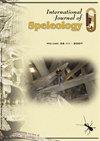Njemica (Biokovo山,克罗地亚)深洞底部异体沉积物中的亚近代微动物群
IF 1.3
4区 地球科学
Q3 GEOSCIENCES, MULTIDISCIPLINARY
引用次数: 0
摘要
对沉积在垂直、近1000米深的Njemica洞穴(克罗地亚比奥科沃山)底部的碎屑沉积物进行了分析。由于洞穴的垂直形态,碎屑沉积物的出现很少。虹吸湖附近的小型、高达分米厚、未受干扰的沉积物堆积揭示了有趣的古生物学和矿物学数据。这些数据被用作讨论沉积过程、沉积物来源和地下动物群古栖息地的有用替代品。在沉积物中发现了介形虫的亚新组合,并表明它们与更广泛的Dinaric喀斯特地区的已知特有物种(Pseudocypidopsis sywulai和Phreatocandona cf.motasi)相关。保存完好的沉积物档案表明了沉积物的同源性,并将其定义为第四纪的异地渗透。碎屑来源于周围地区的更新世-全新世沉积物,其成分受到广阔的亚得里亚海地区火山活动的影响。在平静的水生环境中,悬浮液通过沉淀发生沉淀。因此,沉积物被定义为松弛水沉积物。本文章由计算机程序翻译,如有差异,请以英文原文为准。
Sub-recent microfauna within allogenic sediments at the bottom of a deep cave, Njemica (Biokovo Mt., Croatia)
Clastic sediments deposited at the bottom of the vertical, nearly 1000 m deep Njemica Cave (Biokovo Mountain, Croatia) were analysed. Owing to the vertical morphology of the cave, the occurrences of clastic sediments are sparse. Small, up to decimetre-thick, undisturbed sediment accumulations situated near the siphon lake revealed interesting palaeontological and mineralogical data. These data are used as a useful proxy for discussing depositional processes, the provenance of the sediments and paleo-habitats of the subterranean fauna.
The sub-recent assemblages of ostracods were discovered within the sediment, and they were shown to be correlative to the known endemic species in the wider Dinaric Karst area (Pseudocypridopsis sywulai and Phreatocandona cf. motasi). The well-preserved sediment archive indicates the allogenic origin of the sediment and defines it as an allochthonous infiltrate of the Quaternary. The detritus originates from Pleistocene–Holocene deposits in the surrounding area, whose composition was influenced by volcanic activity in the wide Adriatic region. Sedimentation occurred in a calm aquatic environment by settling from suspension. Therefore the sediments are defined as slackwater deposits.
求助全文
通过发布文献求助,成功后即可免费获取论文全文。
去求助
来源期刊

International Journal of Speleology
地学-地球科学综合
CiteScore
3.10
自引率
23.10%
发文量
12
审稿时长
>12 weeks
期刊介绍:
The International Journal of Speleology has the aim to get cave and karst science known to an increasing number of scientists and scholars. The journal therefore offers the opportunity to all scientists working in and on karst to publish their original research articles or their review papers in an open access, high quality peer reviewed scientific journal at no cost. The journal offers the authors online first, open access, a free PDF of their article, and a wide range of abstracting and indexing services.
 求助内容:
求助内容: 应助结果提醒方式:
应助结果提醒方式:


